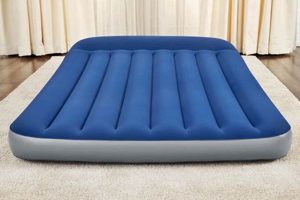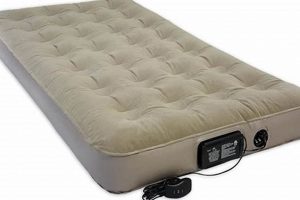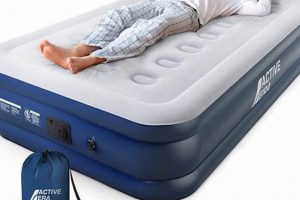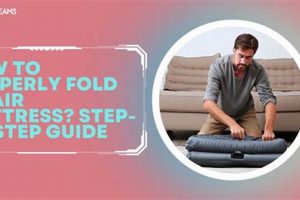A sleep surface designed to promote the circulation of air represents an innovation in bedding technology. Characterized by internal structures or surface designs that facilitate ventilation, these mattresses aim to reduce heat retention and improve overall sleep comfort. For example, some utilize convoluted foam layers or open-cell memory foam to create channels for air movement.
The significance of such designs lies in their ability to mitigate common issues associated with traditional mattresses, such as overheating and trapped moisture. By enhancing breathability, these sleep solutions contribute to a more consistent and comfortable sleep temperature throughout the night. Historically, advancements in mattress technology have focused on improving support and durability; however, thermal regulation represents a crucial and evolving area of focus within the industry.
The subsequent sections will delve into the specific materials, construction techniques, and resulting performance characteristics that define these specialized sleep products. Further analysis will explore the impact on sleep quality, suitability for different sleep preferences, and long-term maintenance considerations.
Optimizing the Performance of Ventilated Mattresses
Maximizing the lifespan and benefits of a sleep surface designed to enhance breathability requires adherence to specific care and usage guidelines.
Tip 1: Utilize a Compatible Bed Frame: Ensure the bed frame provides adequate support and ventilation. Solid platform beds may restrict airflow from beneath, potentially negating some of the mattress’s intended benefits. Slatted frames or those with breathable mesh surfaces are recommended.
Tip 2: Employ Breathable Bedding: Complement the mattress’s ventilating properties by using sheets and blankets made from natural, breathable materials like cotton, linen, or bamboo. These materials facilitate moisture wicking and promote airflow.
Tip 3: Regularly Rotate the Mattress: Rotating the mattress periodically (e.g., every three to six months) helps distribute wear evenly and prevent localized compression of the air-flow channels. This contributes to consistent performance over time.
Tip 4: Maintain a Clean Sleep Environment: Dust mites and allergens can accumulate within any mattress, potentially hindering airflow. Regular vacuuming of the mattress surface is advisable. Consider using a hypoallergenic mattress protector.
Tip 5: Monitor Ambient Humidity: High humidity levels can impede the moisture-wicking capabilities of the mattress and bedding. Employing a dehumidifier in the bedroom may be beneficial, particularly in humid climates.
Tip 6: Heed Manufacturer Instructions: Always consult the manufacturer’s guidelines regarding cleaning, care, and warranty provisions. Deviating from these instructions may void the warranty or negatively impact the mattress’s performance.
Adhering to these guidelines will contribute to a consistent, comfortable, and hygienic sleep environment, thereby maximizing the advantages of a ventilated sleep surface.
The subsequent section will summarize key considerations for selecting the appropriate type of this ventilated sleep system based on individual needs and preferences.
1. Material Breathability
Material breathability forms a fundamental component in the design and effectiveness of any air-circulating mattress. It dictates the extent to which air can permeate the mattress layers, influencing heat dissipation and moisture management. Without adequate breathability in the constituent materials, the advantages of any internal ventilation system are significantly diminished.
- Foam Density and Structure
The density and cellular structure of foam materials, such as memory foam or polyurethane foam, directly impact air permeability. Open-cell foam, characterized by interconnected air pockets, promotes greater airflow compared to closed-cell foam, which has a more compact and less porous structure. Higher-density foams generally restrict airflow more than lower-density options. This inherent material property affects the mattress’s capacity to dissipate heat and moisture.
- Fiber Composition and Weave
The type and construction of fibers used in mattress covers and internal padding layers play a crucial role. Natural fibers, such as cotton, linen, and bamboo, exhibit superior breathability compared to synthetic materials like polyester. The weave pattern also influences airflow; looser weaves allow for greater ventilation. The fiber composition and weave directly affect the surface temperature and moisture levels against the sleeper’s skin.
- Latex Porosity
Latex, a common material in mattresses, can vary significantly in its breathability depending on the manufacturing process. Dunlop latex tends to be denser and less breathable than Talalay latex, which undergoes a process creating a more open and porous structure. This difference in porosity influences the mattress’s ability to regulate temperature and wick away moisture.
- Material Combination Effects
The interplay between different materials within a mattress also affects overall breathability. A mattress combining a breathable cover with a high-density, non-breathable foam layer may still exhibit restricted airflow. Optimal performance requires a synergistic combination of breathable materials throughout the entire mattress construction.
In essence, material breathability is not a singular property but rather a combination of factors that collectively determine the air-exchange capacity of a mattress. Selecting materials with inherent breathability is paramount to maximizing the benefits of any air-circulation design, ultimately contributing to a cooler, drier, and more comfortable sleep environment. The subsequent section will explore how internal ventilation designs interact with these material properties to enhance overall performance.
2. Internal Ventilation Design
The efficacy of a ventilated sleep surface fundamentally depends on its internal ventilation design. This design constitutes the primary mechanism through which air circulates within the mattress, influencing heat dissipation and moisture evaporation. The internal structure dictates the pathways and volume of airflow, directly affecting the mattress’s ability to maintain a comfortable sleep temperature. In the absence of an optimized internal ventilation architecture, even highly breathable materials cannot effectively mitigate heat buildup. A common example is the use of convoluted foam layers, which create channels to facilitate air movement. Without these channels, heat generated by the sleeper’s body remains trapped within the mattress layers.
Several design approaches exist, each with varying de
grees of effectiveness. Horizontal channels cut into the foam core, vertical air vents, and the use of spacer fabrics all contribute to enhanced airflow. The practical significance of a well-engineered design lies in its ability to adapt to changes in sleep position and body weight distribution. For example, some designs incorporate zoned ventilation, providing increased airflow in areas prone to heat accumulation, such as the torso region. Furthermore, the design must account for the potential for dust and allergen accumulation, incorporating features that facilitate cleaning and maintenance. Without proper consideration of these factors, the benefits of a ventilated mattress may be compromised over time.
In conclusion, the internal ventilation design is a critical determinant of a sleep surface’s ability to regulate temperature and moisture. The selection of an appropriate design necessitates careful consideration of material properties, sleeper habits, and environmental conditions. While breathable materials contribute to the overall performance, it is the internal ventilation architecture that orchestrates the movement of air and ultimately defines the mattress’s capacity to deliver a cool and comfortable sleep experience.
3. Thermal Regulation Performance
Thermal regulation performance is a critical attribute of any sleep surface, directly influencing sleep quality and overall comfort. In the context of ventilated mattresses, this performance represents the capacity of the design to maintain a stable and comfortable sleep temperature by dissipating heat and facilitating moisture evaporation. The effectiveness of thermal regulation depends on several interconnected factors, each contributing to the overall ability of the mattress to manage temperature fluctuations.
- Airflow Capacity and Heat Dissipation
Airflow capacity is the primary determinant of thermal regulation performance in ventilated mattresses. The mattress must effectively dissipate heat generated by the sleeper’s body. Higher airflow rates correlate directly with improved heat dissipation. For example, a mattress with strategically placed ventilation channels can significantly reduce heat buildup compared to a traditional foam mattress with limited airflow. This is observed through thermal imaging studies, which demonstrate lower surface temperatures on ventilated mattresses.
- Material Thermal Conductivity
Material thermal conductivity refers to the rate at which heat transfers through a material. Materials with high thermal conductivity, such as copper-infused foam, can efficiently conduct heat away from the sleeper. Conversely, materials with low thermal conductivity, like dense memory foam, tend to trap heat. The choice of materials significantly impacts the mattress’s ability to regulate temperature. The use of thermally conductive materials can enhance heat dissipation and improve overall thermal regulation performance.
- Moisture Management and Evaporation
Effective moisture management is integral to thermal regulation. As the body sweats during sleep, the mattress must efficiently wick away moisture and promote evaporation. Moisture buildup can create a humid environment, leading to discomfort and elevated sleep temperatures. Materials like merino wool possess excellent moisture-wicking properties, contributing to a drier and cooler sleep surface. The ability to manage moisture effectively contributes significantly to overall thermal regulation performance.
- Zoned Temperature Regulation
Zoned temperature regulation involves varying the level of airflow and material properties across different areas of the mattress to address specific temperature needs. For example, areas prone to higher heat accumulation, such as the torso region, may incorporate more ventilation channels or use thermally conductive materials. This targeted approach optimizes thermal regulation by addressing localized temperature variations. Zoned designs demonstrate enhanced thermal regulation performance compared to uniform designs.
In summary, thermal regulation performance is a multifaceted attribute that depends on airflow capacity, material thermal conductivity, moisture management, and targeted design features. The interplay of these factors determines the efficacy of a ventilated sleep surface in maintaining a stable and comfortable sleep temperature. The ability to effectively regulate temperature is a critical consideration when evaluating the overall performance of an air-circulating mattress.
4. Moisture Wicking Capacity
Moisture wicking capacity represents a crucial performance parameter for ventilated mattresses, directly impacting hygiene, comfort, and thermal regulation. Its effectiveness determines the mattress’s ability to draw moisture away from the sleeper’s body, thereby preventing the accumulation of perspiration and minimizing the risk of microbial growth. The inherent properties of the materials used, in conjunction with the designed airflow mechanisms, dictate the overall moisture-wicking performance.
- Fiber Hydrophobicity and Capillary Action
The hydrophobic or hydrophilic nature of mattress fibers plays a significant role. Hydrophobic fibers repel water, while hydrophilic fibers attract it. Effective moisture wicking relies on capillary action, the ability of fibers to draw moisture away from the surface through narrow channels. Materials such as merino wool and specialized polyester blends exhibit superior capillary action, drawing moisture away from the skin. Conversely, less porous materials like standard polyester restrict moisture transport.
- Ventilation-Assisted Evaporation
Airflow within the mattress is critical for facilitating moisture evaporation. After moisture is wicked away from the sleeper, the circulating air stream carries it away from the mattress, preventing saturation and promoting a drier sleep environment. Mattresses with enhanced airflow, achieved through internal channels or open-cell foam structures, exhibit improved evaporative capacity. Insufficient ventilation hinders evaporation, leading to moisture buildup and potential discomfort.
- Material Layering and Moisture Gradients
The arrangement of material layers within the mattress influences moisture management. A strategic layering approach creates a moisture gradient, drawing moisture from the surface towards the core. For instance, a highly absorbent top layer can wick moisture away from the sleeper, while a more breathable inner layer facilitates evaporation. Improper layering can impede moisture movement, leading to localized saturation. Multilayered designs contribute to more effective moisture control.
- Antimicrobial Properties
Moisture accumulation creates a favorable environment for microbial growth. Incorporating materials with inherent antimicrobial properties, such as copper-infused foam or silver-treated fabrics, can inhibit the proliferation of bacteria and fungi. This contributes to improved hygiene and reduces the potential for odors. Antimicrobial properties complement moisture-wicking capacity by mitigating the consequences of retained moisture. The use of antimicrobial materials represents an additional layer of protection against microbial colonization.
In summati
on, moisture wicking capacity is an integral component of a ventilated mattress’s performance. Fiber properties, airflow mechanisms, material layering, and antimicrobial treatments synergistically contribute to effective moisture management. Mattresses with superior moisture-wicking characteristics promote a drier, more hygienic, and more comfortable sleep environment.
5. Sleep Temperature Consistency
Maintaining a consistent sleep temperature throughout the night is crucial for undisturbed and restorative sleep. Sleep temperature consistency, in the context of ventilated mattresses, denotes the capacity of the product to mitigate temperature fluctuations, preventing both overheating and chilling, thereby promoting a stable sleep environment.
- Airflow-Driven Heat Dissipation
Ventilated mattresses leverage airflow to dissipate heat generated by the sleeper’s body. This prevents heat accumulation, a common cause of nighttime awakenings. The presence of ventilation channels or open-cell foam structures facilitates the continuous removal of heat, counteracting the natural tendency for body temperature to rise during sleep. Examples include mattresses with convoluted foam layers or perimeter venting systems that actively circulate air.
- Moisture Management and Evaporative Cooling
Perspiration during sleep contributes to temperature fluctuations. Ventilated mattresses, through their moisture-wicking properties, facilitate evaporative cooling. By drawing moisture away from the body and promoting its evaporation, these mattresses prevent the sensation of dampness and overheating. Materials like merino wool and strategically designed ventilation channels play a key role in this process. For instance, a mattress incorporating a breathable cover and an open-cell foam core efficiently manages moisture and enhances evaporative cooling.
- Insulation and Temperature Buffering
While ventilation is crucial, a balance must be struck with insulation. Ventilated mattresses should provide sufficient insulation to prevent excessive heat loss in cooler environments. The layering of materials, such as a combination of breathable foam and a quilted cover, can create a buffer against temperature fluctuations. An effective ventilated mattress adapts to varying ambient temperatures, ensuring consistent warmth without overheating.
- Microclimate Regulation
Ventilated mattresses create a microclimate around the sleeper, influencing the air immediately surrounding the body. Through consistent airflow and moisture management, these mattresses regulate the temperature and humidity levels within this microclimate. This localized temperature regulation is crucial for maintaining a comfortable sleep environment, minimizing the impact of external temperature changes. For example, a mattress with zoned ventilation can provide targeted cooling to specific areas of the body, ensuring a consistent microclimate.
The facets discussed highlight the complex interplay between airflow, moisture management, insulation, and microclimate regulation in achieving consistent sleep temperature. Ventilated mattresses, through their innovative design and material selection, actively work to minimize temperature fluctuations, thereby promoting more restful and restorative sleep.
6. Support Layer Integration
The integration of the support layer within a ventilated mattress significantly influences its overall performance and longevity. The support layer, typically composed of high-density foam, innersprings, or a hybrid combination, provides the foundational stability and spinal alignment necessary for comfortable sleep. Its design and interaction with the upper layers that facilitate airflow dictate the efficacy of the ventilation system and the overall feel of the mattress. Inadequate support undermines the benefits of enhanced airflow, potentially leading to pressure points, discomfort, and reduced sleep quality. For instance, a ventilated memory foam mattress with a weak or poorly designed support core may sag over time, compromising both its supportive capabilities and its ventilation channels, thus diminishing its ability to regulate temperature effectively. A well-integrated support layer maintains the structural integrity of the ventilation system, ensuring consistent airflow and preventing localized compression.
Effective support layer integration involves several considerations. The density and type of material used in the support core must be compatible with the upper layers designed for ventilation. Innerspring systems, for example, can promote airflow from beneath, complementing the surface ventilation features. However, the spring gauge and coil density must be optimized to provide adequate support without creating pressure points. Similarly, high-density foam support cores should be designed with channels or perforations to ensure continued airflow. The construction must also account for the potential for differential compression. A support layer that compresses unevenly can disrupt the airflow patterns, leading to localized heat buildup. Manufacturers often utilize zoning techniques, where different areas of the support layer are engineered with varying levels of firmness to accommodate different body weights and sleep positions, thereby maintaining consistent support and airflow.
In summary, support layer integration is a critical factor in the performance of ventilated mattresses. The support layer must not only provide adequate spinal alignment and pressure relief but also complement and enhance the functionality of the ventilation system. Proper integration ensures consistent airflow, prevents structural degradation, and contributes to long-term durability. The overall effectiveness of a ventilated mattress is inextricably linked to the design and performance of its support layer.
7. Long-Term Durability
Long-term durability constitutes a critical attribute of any sleep surface, particularly those designed to facilitate air circulation. The ability of a ventilated mattress to maintain its performance characteristics over an extended period directly influences its value proposition and user satisfaction. Durability encompasses not only the physical integrity of the mattress but also its continued ability to effectively regulate temperature and manage moisture.
- Material Degradation Resistance
The inherent resistance of constituent materials to degradation significantly impacts long-term durability. Foams, fabrics, and other components must withstand repeated compression, tension, and exposure to environmental factors such as humidity and temperature fluctuations. High-quality materials, such as durable latex or high-density polyurethane foam, exhibit greater resistance to breakdown, preserving the mattress’s structural integrity and ventilating properties. Conversely, lower-quality materials are prone to premature deterioration, leading to sagging, reduced airflow, and diminished comfort.
- Structural Integrity Under Load
The mattress’s ability to maintain its structural integrity under continuou
s load is paramount. Over time, repeated compression can lead to deformation of the foam layers, collapse of ventilation channels, and weakening of support structures. A well-designed mattress incorporates robust construction techniques, such as reinforced edges and strategically placed support elements, to distribute weight evenly and prevent localized stress concentrations. This ensures that the mattress retains its shape and supportive properties over an extended lifespan. Hybrid designs, incorporating both foam and innerspring components, often offer enhanced structural stability. - Resistance to Microbial Growth
The long-term durability of a ventilated mattress is also affected by its resistance to microbial growth. Moisture accumulation can create a favorable environment for bacteria, mold, and dust mites, leading to material degradation, unpleasant odors, and potential health concerns. Mattresses incorporating antimicrobial treatments or utilizing inherently antimicrobial materials, such as copper-infused foam or silver-treated fabrics, exhibit enhanced resistance to microbial colonization. Regular cleaning and maintenance practices also contribute to preventing microbial growth and prolonging the mattress’s lifespan.
- Ventilation Channel Maintenance
The long-term efficacy of a ventilated mattress depends on the continued functionality of its ventilation channels. Over time, these channels can become obstructed by dust, debris, or compressed foam, reducing airflow and diminishing the mattress’s ability to regulate temperature effectively. Mattresses designed with easily accessible and cleanable ventilation systems offer enhanced durability. Additionally, the use of resilient materials that resist compression and maintain their shape prevents the collapse of ventilation channels, ensuring consistent airflow throughout the mattress’s lifespan.
In summary, the long-term durability of a ventilated mattress depends on a complex interplay of factors, including material degradation resistance, structural integrity under load, resistance to microbial growth, and ventilation channel maintenance. Mattresses engineered with high-quality materials, robust construction techniques, and effective antimicrobial measures exhibit enhanced durability, providing consistent performance and prolonged comfort over an extended period.
Frequently Asked Questions
The following addresses common inquiries and misconceptions regarding sleep surfaces designed to promote air circulation, offering clarity on their functionality and benefits.
Question 1: What distinguishes an air flow mattress from a traditional mattress?
An air flow mattress is specifically engineered with internal structures or materials that facilitate air circulation, reducing heat retention. Traditional mattresses often lack these features, potentially leading to overheating and discomfort.
Question 2: Is an air flow mattress suitable for all sleep positions?
The suitability depends on the specific design and construction. While the enhanced breathability benefits all sleepers, the support layer must align with individual preferences and sleep posture requirements for optimal comfort and spinal alignment.
Question 3: Does an air flow mattress require specialized cleaning procedures?
While routine cleaning methods apply, adherence to the manufacturer’s guidelines is crucial. Certain cleaning agents or techniques may compromise the integrity of the ventilation system or the mattress materials.
Question 4: Does an air flow mattress eliminate the need for air conditioning?
An air flow mattress enhances thermal regulation but does not replace air conditioning. It complements environmental controls by promoting a cooler sleep surface, potentially reducing the reliance on air conditioning but not eliminating it entirely.
Question 5: Are air flow mattresses more expensive than traditional mattresses?
The price varies depending on the materials, construction, and brand. While some air flow mattresses may command a premium due to specialized engineering, the long-term benefits in comfort and sleep quality may justify the investment.
Question 6: How does the lifespan of an air flow mattress compare to that of a traditional mattress?
The lifespan depends on the quality of materials and construction. A well-maintained air flow mattress, constructed with durable materials, can offer a comparable or even extended lifespan relative to a traditional mattress.
In essence, an informed decision regarding a sleep surface requires a thorough understanding of its attributes, benefits, and limitations. An air flow mattress represents a technology that can significantly enhance sleep comfort by promoting thermal regulation.
The subsequent section will provide a comparative analysis of different air flow mattress designs, highlighting their respective strengths and weaknesses.
Conclusion
This exploration of air flow mattress technology reveals its fundamental role in promoting enhanced sleep quality through improved thermal regulation. Key aspects, including material breathability, internal ventilation design, and support layer integration, collectively determine the mattress’s ability to maintain a consistent and comfortable sleep temperature. Long-term durability, contingent upon material quality and construction techniques, ensures the sustained effectiveness of these performance attributes.
Continued research and development within the bedding industry will likely yield further advancements in air flow mattress design, optimizing ventilation strategies and material selection. The significance of these innovations lies in their potential to mitigate sleep disturbances related to temperature and moisture, ultimately contributing to improved health outcomes. Prospective consumers are encouraged to consider individual sleep preferences and environmental factors when evaluating the diverse array of ventilated sleep surfaces available.







